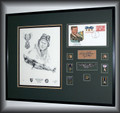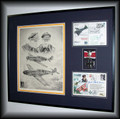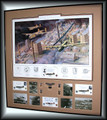 Loading... Please wait...
Loading... Please wait...Categories
Our Newsletter
- Home
- Combat Aircraft/Pencil Drawings ~ Free Shipping
- Cessna A-37 "Dragonfly" ~ Free Shipping
Product Description
Print Size: 8½”x 11” ---- Unlimited Print Edition
In 1962, the US Air Force’s Special Air Warfare Center decided to evaluate the T-37 trainer as a future Counter-Insurgency (COIN) light attack aircraft. The T-37 "Tweet" had been in continuous service with the US Air Force since 1957, and had amassed an excellent service-reliability history. Two T-37Bs were tested with their original 1,025-lb thrust Continental J69 engines. The aircraft were loaded to a takeoff weight of 8,700 pounds, almost 33% above their normal maximum, and were understandably found to be somewhat lacking in performance. Subsequently, each aircraft was modified with a pair of 2,400-lb thrust General Electric J85-GE-5 turbojets, and were designated YAT-37Ds. Flight testing showed that the new aircraft could be safely flown at weights up to 14,000 pounds, which allowed for the carriage of a wide variety of weapons. Nothing became of the project until 1966, when the US Air Force’s involvement in Vietnam highlighted the need for a light strike-fighter. Cessna was contracted to convert 39 T-37B trainers procured from the boneyard at Davis-Monthan Air Force Base. Delivery of the new aircraft, now called the A-37A Dragonfly, began in May 1967. In addition to the larger engines, the aircraft was equipped with eight underwing hard-points and wingtip tanks. The first 25 A-37As underwent operational evaluation in South Vietnam and were eventually transferred first to the 604th Air Commando Squadron at Bien Hoa, then to the South Vietnamese Air Force in 1970. Meanwhile, Cessna had built a prototype called the Model 318E which, while based on the T-37, had significant differences. Its airframe was stressed for 6 Gs, the fuel load was increased to 507 US gallons (1920 liters) plus 400 more gallons (1516 liters) in four underwing auxiliary tanks, and it had air-refueling capability. The aircraft was predictably re-designated the A-37B and, like the A-model, had a 7.62-mm Gattling Minigun in the nose, gun cameras, and armor protection for the pilots. It also had self-sealing fuel tanks, a tracking beacon system, and the ability to directionally track VHF and UHF signals. This prototype of the B-model was first flown in September 1967 and deliveries began in May 1968. In addition to service with the US Air Force, the A-37 was supplied in small numbers to the South Vietnamese Air Force, Turkey, several South American air forces, and the US Air National Guard, where it remained in service into the early 1990s as an observation and light-attack derivative called the OA-37B. The A-37 is still active in South America, where it has soldiered on into the 21st century. Several have also made their way into the caring hands of private collectors, and it is probable that airshow audiences will begin to see them appearing on an increasingly regular basis.













